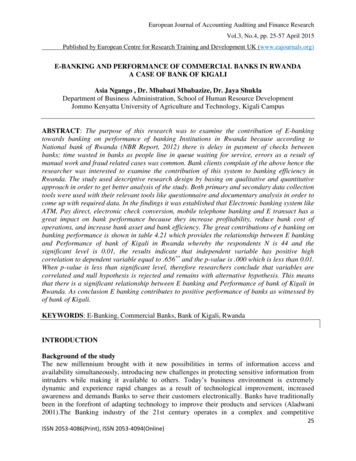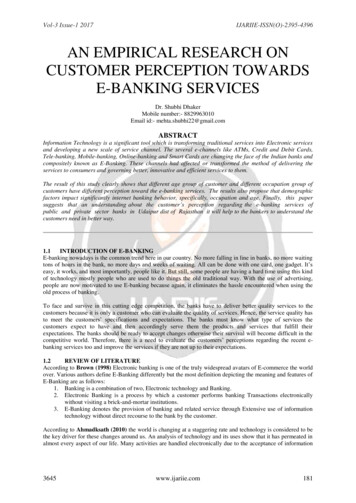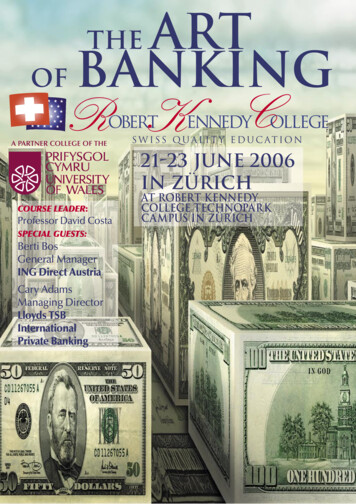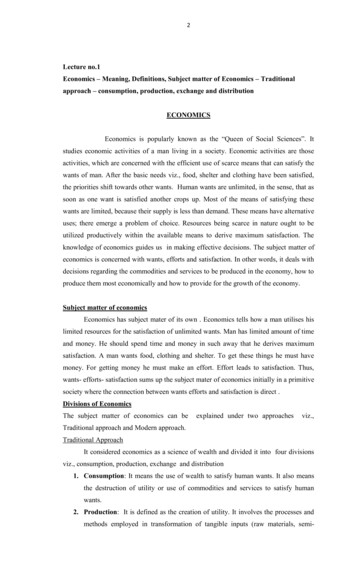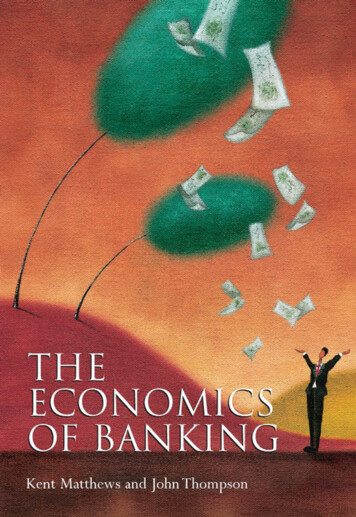
Transcription
THE ECONOMICS OF BANKING
THE ECONOMICSOF BANKINGKENT MATTHEWSandJOHN THOMPSON
Copyright # 2005John Wiley & Sons Ltd, The Atrium, Southern Gate, Chichester,West Sussex PO19 8SQ, EnglandTelephone: (þ44) 1243 779777Email (for orders and customer service enquiries): cs-books@wiley.co.ukVisit our Home Page on www.wiley.comAll Rights Reserved. No part of this publication may be reproduced, stored in a retrieval system ortransmitted in any form or by any means, electronic, mechanical, photocopying, recording,scanning or otherwise, except under the terms of the Copyright, Designs and Patents Act 1988 orunder the terms of a licence issued by the Copyright Licensing Agency Ltd, 90 Tottenham CourtRoad, London W1T 4LP, UK, without the permission in writing of the Publisher. Requests to thePublisher should be addressed to the Permissions Department, John Wiley & Sons Ltd, TheAtrium, Southern Gate, Chichester, West Sussex PO19 8SQ, England, or emailed topermreq@wiley.co.uk, or faxed to (þ44) 1243 770620.This publication is designed to provide accurate and authoritative information in regard to thesubject matter covered. It is sold on the understanding that the Publisher is not engaged inrendering professional services. If professional advice or other expert assistance is required, theservices of a competent professional should be sought.Other Wiley Editorial O cesJohn Wiley & Sons Inc., 111 River Street, Hoboken, NJ 07030, USAJossey-Bass, 989 Market Street, San Francisco, CA 94103-1741, USAWiley-VCH Verlag GmbH, Boschstr. 12, D-69469 Weinheim, GermanyJohn Wiley & Sons Australia Ltd, 33 Park Road, Milton, Queensland 4064, AustraliaJohn Wiley & Sons (Asia) Pte Ltd, 2 Clementi Loop #02-01, Jin Xing Distripark, Singapore 129809John Wiley & Sons Canada Ltd, 22 Worcester Road, Etobicoke, Ontario, Canada M9W 1L1Wiley also publishes its books in a variety of electronic formats. Some content that appears inprint may not be available in electronic books.Library of Congress Cataloging-in-Publication DataMatthews, Kent.The economics of banking / Kent Matthews, John Thompson.p. cm.Includes bibliographical references and index.ISBN 0-470-09008-1 (pbk. : alk. paper)1. Banks and banking. 2. Microeconomics. I. Thompson, John L. II. Title.HG1601.M35 2005332.1 dc222005004184British Library Cataloguing in Publication DataA catalogue record for this book is available from the British LibraryISBN-13 978-0-470-09008-4ISBN-10 0-470-09008-1Project management by Originator, Gt Yarmouth, Norfolk (typeset in 10/12pt Bembo)Printed and bound in Great Britain by Antony Rowe Ltd, Chippenham, WiltshireThis book is printed on acid-free paper responsibly manufactured from sustainable forestryin which at least two trees are planted for each one used for paper production.
TABLE OF CONTENTSAbout the AuthorsviiPrefaceix1. Trends in Domestic and International Banking12. Financial Intermediation: The Impact of the Capital Market193. Banks and Financial Intermediation334. Retail and Wholesale Banking515. International Banking636. The Theory of the Banking Firm777. Models of Banking Behaviour918. Credit Rationing1139. Securitization12910. The Structure of Banking14111. Bank Regulation16112. Risk Management18313. The Macroeconomics of Banking205References225Index233
ABOUT THE AUTHORSKent Matthews received his economics training at the London School ofEconomics, Birkbeck College and the University of Liverpool, receiving his PhDfor Liverpool in 1984. He is currently the Sir Julian Hodge Professor of Bankingand Finance at Cardi¡ Business School, Cardi¡ University. He has held researchappointments at the National Institute of Economic and Social Research, Bank ofEngland and Lombard Street Research Ltd and faculty positions at the Universitiesof Liverpool, Western Ontario, Leuven, Liverpool John Moores and Humbolt. Heis the author and co-author of six books and over 60 articles in scholarly journalsand edited volumes.John Thompson worked in industry until 1967 when he joined LiverpoolJohn Moores University (then Liverpool Polytechnic) as an assistant lecturer inEconomics. He took degrees in Economics at the University of London and theUniversity of Liverpool and obtained his PhD from the latter in 1986. He wasappointed to a personal chair in Finance becoming Professor of Finance in 1995 andthen in 1996 Emeritus Professor of Finance. He is the author and co-author of ninebooks and numerous scholarly papers in the area of Finance and Macroeconomics.
PREFACEThere are a number of good books on banking in the market; so, why should theauthors write another one and, more importantly, why should the student beburdened with an additional one? Books on banking tend to be focused on themanagement of the bank and, in particular, management of the balance sheet. Suchbooks are specialized reading for students of bank management or administration.Students of economics are used to studying behaviour (individual and corporate) inthe context of optimizing behaviour subject to constraints. There is little in themarket that examines banking in the context of economic behaviour. What littlethere is, uses advanced technical analysis suitable for a graduate programme ineconomics or combines economic behaviour with case studies suitable for bankingMBA programmes. There is nothing that uses intermediate level microeconomicsthat is suitable for an undergraduate programme or nonspecialist postgraduateprogrammes.This book is aimed at understanding the behaviour of banks and at addressingsome of the major trends in domestic and international banking in recent timesusing the basic tools of economic analysis. Since the 1950s great changes have takenplace in the banking industry. In particular, recent developments include:(i) Deregulation of nancial institutions including banks with regard to theirpricing decisions, though in actual fact this process has been accompanied byincreased prudential control.(ii) Financial innovation involving the development of new processes and nancialinstruments. New processes include new markets such as the Eurocurrencymarkets and securitization as well as the enhanced emphasis of risk managementby banks. Certi cates of Deposit, Floating Rate Notes and Asset BackedSecurities are among the many examples of new nancial instruments.(iii) Globalization so that most major banks operate throughout the world ratherthan in one country. This is evidenced by statistics reported by the Bank forInternational Settlements (BIS). In 1983 the total holdings of foreign assets bybanks reporting to the BIS amounted to 754,815bn. In 2003 this gure hadrisen to 14,527,402bn.(iv) All the above factors have led to a strengthening in the degree of competitionfaced by banks.This text covers all these developments. Chapters 1 3 provide an introductionsurveying the general trends and the role of the capital market, in general, andbanks, in particular, in the process of nancial intermediation. Chapters 5 and 6cover the di¡erent types of banking operation.Discussion of theories of the banking rm takes place in Chapters 6 and 7.Important recent changes in banking and bank behaviour are examined in Chapters
PREFACEx8 and 9. These include credit rationing, securitization, risk management and thestructure of banking. Finally, the relationships between banks and macroeconomicpolicy are analysed in Chapter 13.The exposition should be easily accessible to readers with a background inintermediate economics. Some algebra manipulation is involved in the text butthe more technical aspects have been relegated to separate boxes, the detailedunderstanding of which are not necessary to follow the essential arguments of themain text.Our thanks for help go to our colleagues Professor Chris Ioannidis of BathUniversity, Professor Victor Murinde of Birmingham University, Professor C. L.Dunis and Jason Laws of Liverpool John Moores University for helpful discussionsat various stages of the writing, and to Tianshu Zhao of the University of WalesBangor for comments on the nal draft. The year 3 students of the Domestic andInternational Banking Module at Cardi¡ University made a number of useful (andcritical!) comments, as did students from the postgraduate module on InternationalBanking. They are all, of course, exonerated from any errors remaining in the text,which are our sole responsibility.Kent MatthewsCardi¡ UniversityJohn ThompsonLiverpool John Moores University
CHAPTER 1TRENDS IN DOMESTIC ANDINTERNATIONAL BANKINGMINI-CONTENTS1.11.1 Introduction11.2 Deregulation31.3 Financial innovation41.4 Globalization71.5 Profitability81.6 Conclusion161.7 Summary16INTRODUCTIONThe main thrust of this chapter is to introduce the major changes that have takenplace in the banking sector and to set the context for later discussion. Aggregatetables and statistics are employed to highlight the nature of the changes. Itshould also be noted that many of these changes are examined in more detail lateron in the book. It is also necessary at this stage to explain the nature of variousratios, which we will use throughout this text. The relevant details are shown inBox 1.1.Banking is not what it used to be. In an important study, Boyd and Gertler(1994) pose the question, ‘Are banks dead? Or are the reports grossly exaggerated?’They conclude, not dead, nor even declining, but evolving. The conventionalmono-task of taking in deposits and making loans remains in di¡erent guises but itis not the only or even the main activity of the modern bank. The modern bank is amultifaceted nancial institution, sta¡ed by multi-skilled personnel, conductingmultitask operations. Banks have had to evolve in the face of increased competitionboth from within the banking sector and without, from the non-bank nancialsector. In response to competition banks have had to restructure, diversify,improve e ciency and absorb greater risk.Banks across the developed economies have faced three consistent trends thathave served to alter the activity and strategy of banking. They are (i) deregulation,(ii) nancial innovation and (iii) globalization. We will see that that the forcesreleased by each of these trends are not mutually exclusive. The development of the
TRENDS IN DOMESTIC AND INTERNATIONAL BANKING2BOX 1.1Illustration of the derivation of key ratiosSimple stylized examples of a bank’s profit and loss (income) account and itsbalance sheet are shown below. Note in these accounts for the purpose ofsimplicity we are abstracting from a number no other items such as bad debtsand depreciation and taxation.Stylized Balance SheetAssetsLiabilitiesCashLiquid assetsLoans and advancesFixed assets 10010006000200Total7300Sight depositsTime depositsBondsEquity 3000250010008007300Stylized Profit and Loss (Income) AccountInterest income Non-interest (fee) incomeLess interest expensesLess operating expenses 700600600500 Gross profit200The key ratios are easily derived from these accounts as is demonstratedbelow:Return On Assets ðROAÞ¼ ð200 7300Þ 100 ¼ 2:7%Return On EquityðROEÞ¼ ð200 800Þ 100 ¼ 25%Net Interest Margin ðNIMÞ¼ ð700 600Þ 7300Þ 100 ¼ 1:4%Operating Expense ðOEÞ ratio ¼ ð500 7300Þ 100 ¼ 6:8%eurodollar market1 arose out of a desire to circumvent regulation in the USA (eurocurrency banking is examined in Chapter 5). Deregulation of the interest ceiling ondeposits led to the nancial innovation of paying variable interest rates on demanddeposits. Deregulation has also allowed global forces to play a part in the development of domestic banking services which was thought to have barriers to entry.1The term ‘eurodollar’ is a generic term for deposits and loans denominated in a currencyother than that of the host country. Thus, for example, both euro and dollar deposits inLondon are eurodollars.
DEREGULATION3There have been a number of comprehensive surveys of the process of nancialinnovation and deregulation in developed economies’ banking systems.2 Thischapter describes the trends in banking that have arisen as a result of the forces ofderegulation, nancial innovation and globalization, over the last two decades ofthe 20th century. What follows in the remainder of this book is an attempt todemonstrate the value of economic theory in explaining these trends.1.2DEREGULATIONThe deregulation of nancial markets and banks in particular has been a consistentforce in the development of the nancial sector of advanced economies during thelast quarter of the 20th century. Deregulation of nancial markets and banks hasbeen directed towards their competitive actions, but this has been accompanied byincreased regulation over the soundness of their nancial position. This is called‘prudential control’ and is discussed further in Chapter 11. Consequently, there is adichotomy as far as the operations of banks are concerned; greater commercialfreedom (i.e., deregulation) but greater prudential control (i.e., more regulation).Deregulation consists of two strands; removal of impositions of governmentbodies such as the Building Societies Act discussed below and removal of selfimposed restrictions such as the building society cartel whereby all the societiescharged the same lending rates and paid the same deposit rates. The process of deregulation across the developed economies has come in three phases but not always inthe same sequence. The rst phase of deregulation began with the lifting of quantitative controls on bank assets and the ceilings on interest rates on deposits. In the UKcredit restrictions were relaxed starting with Competition and Credit Control31971. In the USA it began with the abolition of regulation Q 1982.4 In the UK, theinitial blast of deregulation had been tempered by imposition of the ‘Corset’5during periods of the 1970s to constrain the growth of bank deposits and, thereby,the money supply. By the beginning of the 1980s, exchange control had ended inthe UK and the last vestige of credit control had been abolished.6 Greaterintegration of nancial services in the EU has seen more controls on the balancesheets of banks being lifted.72See in particular Baltensperger and Dermine (1987), Podolski (1986) and Gowland (1991).The policy termed ‘Competition and Credit Control’ removed direct controls and encouraged banks to compete more aggressively.4Regulation Q set a ceiling on the interest rate that banks could pay on time deposits. Theobject was to protect Savings and Loan Associations (roughly the equivalent of UK buildingsocieties) from interest rate competition.5This was a policy whereby banks were compelled to lodge non-interest-bearing deposits atthe Bank of England if the growth of their interest-bearing deposits grew above a speci edlevel. The basic idea was to prevent banks from competing for funds.6In the UK hire purchase control had been abolished by 1981.7For a review see Vives (1991).3
4TRENDS IN DOMESTIC AND INTERNATIONAL BANKINGThe second phase of deregulation was the relaxation of the specialization ofbusiness between banks and other nancial intermediaries allowing both parties tocompete in each other’s markets. In the UK this was about the opening up of themortgage market to competition between banks and building societies in the1980s. The Building Societies Act 1986 in turn enabled building societies toprovide consumer credit in direct competition with the banks and specialized creditinstitutions. In the USA, the Garn St Germain Act 1982 enabled greater competition between the banks and the thrift agencies. A further phase came later in1999 with the repeal of the Glass Steagal Act (1933)8 that separated commercialbanking from investment banking and insurance services.The third phase concerned competition from new entrants as well as increasingcompetition from incumbents and other nancial intermediaries. In the UK, newentrants include banking services provided by major retail stores and conglomerates(Tesco Finance, Marks & Spencer, Virgin) but also the new nancial arms of older nancial institutions that o¡er online and telephone banking services (Cahoot part of Abbey National, Egg 79% owned by Prudential). In the USA new entrantsare the nancial arms of older retail companies or even automobile companies(Sears Roebuck, General Motors). Internationally, GE Capital owned by GeneralElectrical is involved in industrial nancing, leasing, consumer credit, investmentand insurance. In 2002 this segment of General Electrical accounted for over onethird of its total revenue of 132bn.91.3FINANCIAL INNOVATION‘Financial innovation’ is a much-overused term and has been used to describe anychange in the scale, scope and delivery of nancial services.10 As Gowland (1991)has explained, much of what is thought to be an innovation is the extension or imitation of a nancial product that already existed in another country. An example isthe introduction of variable rate mortgages into the USA when xed rates were thenorm and xed rate mortgages in the UK, where variable rates still remain thedominant type of mortgage.It is generally recognized that three common but not mutually exclusive forceshave spurred on nancial innovation. They are (i) instability of the nancial environment, (ii) regulation and (iii) the development of technology in the nancial sector.Financial environment instability during the 1970s was associated with volatile andunpredictable in ation, interest rates and exchange rates and, consequently,increased demand for new instruments to hedge against these risks. Regulation thattended to discriminate against certain types of nancial intermediation led to8The Financial Services Competition Act (1999), allows commercial banks to have a liatedsecurities rms in the USA.9Annual Report www.ge.com10A dated but excellent survey of nancial innovation in banking can be found in the Bank forInternational Settlements (BIS, 1986) report.
FINANCIAL INNOVATION5regulatory arbitrage whereby nancial institutions relocated o¡shore in weaklyregulated centres. It was the regulation of domestic banks in the USA that led tothe development of the eurodollar market o¡shore. At the same time, technologicaldevelopment has created a means of developing a wide range of bank products andcost reductions, thus meeting the demand for new instruments mentioned above.The advance of technology can be viewed in the same way as Schumpeter’s wavesof technological innovation and adaptation. The rst wave can be thought of as theapplication of computer technology in the bank organization. This would not onlybe bank-speci c but also applicable to all service sector enterprises that are involvedin the ordering, storing and disseminating of information such as, for example,rating agencies. The second wave involves the application of telecommunicationand computer technology to the improvement of money management methodsfor the consumer. The third wave involves the customer information le, whichenables nancial institutions to gather information about the spending patterns and nancial needs of their clients so as to get closer to the customer. The fourth wave isthe further development of electronic payment methods, such as smart cards, e-cashand on-line and home banking services.Technological nancial services are spread through competition and demandfrom customers for services provided by other banks and nancial intermediaries.Figure 1.1 describes the process of nancial innovation.The three forces of nancial instability, regulation and technology put pressureon banks to innovate. Innovation also creates a demand for new nancial productswhich feed back into the banking system through customer reaction and demand.The in uence of the three factors and the feedback from customer demand for nancial services is shown in Figure 1.1.FIGURE 1.1The process of financial ncialinstabilityFinancialinnovationDemand for newfinancial services
TRENDS IN DOMESTIC AND INTERNATIONAL BANKING6Goodhart (1984) identi ed three principal forms of structural change due to nancial innovation. They are in turn:(1) The switch from asset management to liability management.(2) The development of variable rate lending.(3) The introduction of cash management technology.Asset management tted easily into the post-war world of bank balance sheetsswollen with public sector debt and quantitative controls on bank lending. Thebasic idea behind the concept of asset management is that banks manage their assetsregarding duration and type of lending subject to the constraint provided by theirholdings of reserve assets. The move to liability management (namely, their abilityto create liabilities by, for example, borrowing in the inter-bank market) came inthe USA by banks borrowing from the o¡shore eurodollar market (often fromtheir own overseas branches) in an attempt to circumvent the restrictions of regulation Q. The ceiling on the rate payable on deposits drove savers to invest in securitiesand mutual funds. In the UK, liability management was given a boost with theCompetition and Credit Control Act 1971. With asset management, the total quantity of bank loans was controlled by restriction and deposits were supplied passivelyto the banking system.Volatile in ation and interest rates during the 1970s led to the further development of variable rate lending. Blue chip customers always had access to overdraftfacilities at variable rates but during the 1970s more and more companies switchedto variable rate loans (linked to the London Inter Bank O¡er Rate LIBOR).Banks were able to lend to customers subject to risk, competitive pressure andmarginal costs of lending. The total stock of bank loans became determined bythe demand for bank credit (this implies a near-horizontal supply of bank loanscurve). The development of liability management and variable rate lending led tothe rapid expansion of bank balance sheets. Banks managing their liabilities by altering interest rates on deposits and borrowing from the inter-bank market satis edthe demand for bank loans. Thus, the simplest type of nancial innovation was thedevelopment of interest-bearing demand deposits which enabled banks to liabilitymanage.The pace of technological innovation in banking has seen the development ofnew nancial products that have also resulted in a decline in unit costs to theirsuppliers the banks. Credit cards, Electronic Fund Transfer (EFT), AutomatedTeller Machines (ATMs), Point Of Sale (POS) machines have had the dual e¡ect ofimproving consumer cash management techniques and reducing the costs of delivery of cash management services. A good example is the use of debit cards overcheques. The costs of clearing a cheque are 35p per item compared with 7p perdebit card transaction.1111Association of Payment Clearing Services information o ce, www.apacs.org.uk
GLOBALIZATION1.47GLOBALIZATIONThe globalization of banking in particular has paralleled the globalization of the nancial system and the growth in multinational corporations in general. To someextent banking has always been global. The internationalization of banking in thepost-war world has resulted from the ‘push’ factors of regulation in the homecountry and the ‘pull’ factors of following the customer.12 This explanation of theinternationalization of banking ts particularly well with the growth of USbanking overseas. Restrictions on interstate banking13 impeded the growth ofbanks, and restrictions on their funding capacities drove US banks abroad. Theby-product of this expansion was the creation of the eurodollar market in London the most liberally regulated environment at the time. The ‘pull’ factor wasprovided by the expansion of US multinationals into Europe. US banks such asCitibank and Bank of America expanded into Europe with a view to holding on totheir prime customers. Once established in Europe they recognized the advantagesof tapping into host country sources of funds and to o¡er investment-bankingservices to new clients.Canals (2002) typi es the globalization process in terms of three strands. The rst is the creation of a branch network in foreign countries. The most notableexample of this strategy has been Citibank and Barclays. The second strand ismerger or outright takeover. The third strand is an alliance supported by minorityshareholding of each other’s equity. The 1980s and 1990s have seen a raft of strategicalliances and takeovers in the EU, beginning with Deutsche Bank’s purchase ofMorgan Grenfell in 1984.14The progressive relaxation of capital controls has added to the impetus forglobalization in banking. Table 1.1 shows the increasing foreign currency positionof the major banking economies since 1983. Foreign claims refer to claims onborrowers resident outside the country in which the bank has its headquarters.15The rapid growth of foreign asset exposure is particularly striking in the case of theUK, which has seen foreign currency assets increase its share from under 20% oftotal assets in 1983 to over 30% in 2003.The pace of globalization in banking was furthered by the increasing trend tosecuritization (securitization is examined in greater detail in Chapter 9). ‘Securitization’ is a term that describes two distinct processes. First, it can be thought of as theprocess by which banks unload their marketable assets typically mortgages, andcar loans onto the securities market. These are known as Asset Backed Securities(ABSs). Second, it can be thought of as the process of disintermediation wherebythe company sector obtains direct nance from the international capital market12An overview of the determinants of the internationalization of nancial services is in Walter(1988).13The Bank Holding Act 1956 e¡ectively prohibited interstate banking.14For a recent review of trends in the EU see Dermine (2003).15The gures include the foreign currency loans of the branches of domestic banks located inforeign countries.
TRENDS IN DOMESTIC AND INTERNATIONAL BANKING8TABLE 1.1Total foreign claims ( 788.6Source: BIS.* 2nd quarter only.with the aid of its investment bank. Large companies are frequently able to obtainfunds from the global capital market at more favourable terms than they couldfrom their own bank. Banks have often led their prime customers to securitizeknowing that while they lose out on their balance sheets they gain on fee income.The trend to harmonization in regulation has also facilitated the globalizationprocess. The creation of a single market in the EU and the adoption of the SecondBanking Directive 1987 8 was done with the view to the creation of a single passport for banking services. The second directive addressed the harmonization ofprudential supervision; the mutual recognition of supervisory authorities withinmember states, and home country control and supervision. The result of furtherintegration of the EU banking market will see a stronger urge to cross-border nancial activity and greater convergence of banking systems.161.5PROFITABILITYThe forces of competition unleashed by the deregulatory process have had starkimplications for bank pro tability. Banks faced competition on both sides of thebalance sheet. Table 1.2 shows the evolution of bank pro tability measured by theReturn On Assets (ROA) see Box 1.1. The e¡ect of nancial innovation andglobalization has been to expand banks’ balance sheets in both domestic and foreignassets. Pro ts as a per cent of assets declined in most cases both as balance sheetsexpanded and as competition put pressure on pro tability. However, the banks ofsome countries have been successful in reducing costs and restoring ROA but thepressure on pro ts has been a consistent theme.Table 1.2 shows that ROA has been particularly weak during the low period of16For an analysis of convergence of banking systems see Mullineux and Murinde (2003).
PROFITABILITY9TABLE 1.2Return on assets 1.11.70.50.40.00.91.42.00.70.2 e commercial banks, source: OECD.the business cycle but in general has been weak overall. Figures for 2001 and 1999show that the USA, UK and France have been successful in restoring pro tability.Banks in Switzerland have been able to maintain their position of the past 25 years.In the case of the US, and France, the ROA for the year 2001 is higher than that for1979. In most cases the corresponding gures are lower. Taking out the e¡ects ofthe cycle tends to con rm the common pattern of declining ROA except in thecase of the US.Figure 1.2 illustrates a similar decline in ROA for the Barclays Group in theUK. At the end of the 1970s the consolidated ROA of the Barclays Group wasFIGURE 1.2ROA and operating expenses, Barclays Group UK6ROAOp Expenses5.55Percent of 02005
TRENDS IN DOMESTIC AND INTERNATIONAL BANKING105.5% but by the end of the 20th century it had fallen to 3.5% but still higher than theUK average of 1.1%. (The decline in the average gures is 64% but for Barclays itis 36%.)Prior to the major deregulatory forces of the 1980s, bank margins wererelatively wide and also in uenced by the level of interest rates. The rise in interestrates that accompanied a rise in in ation increased margins because a signi cantproportion of deposits (i.e., sight deposits) paid no interest whereas all assets exceptthe minimal deposits at the Bank of England earned interest linked to the o cialbank rate. This was known as the endowment e¡ect, which is made of twocomponents the net interest margin and the net interest spread:Endowment effect ¼ Net interest margin Net interest spreadNet interest margin ¼ Net interest in
Economics, Birkbeck College and the University of Liverpool, receiving his PhD for Liverpool in 1984. He is currently the Sir Julian Hodge Professor of Banking . is the author and co-author of six books and over 60 articles in scholarly journals andeditedvolumes. John Thompson worked in industry until 1967 when he joined Liverpool




